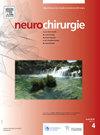Using fluid mechanics to reduce postoperative pneumocephalus during chronic subdural hematoma burr hole surgery: Technical note
IF 1.4
4区 医学
Q4 CLINICAL NEUROLOGY
引用次数: 0
Abstract
Symptomatic chronic subdural hematoma is a prevalent conditions among the elderly, making burr hole surgical evacuation a very frequent cranial neurosurgical procedure. Recurrence of chronic subdural hematoma requiring revision surgery is associated with higher morbidity and mortality. Decreasing postoperative pneumocephalus is a simple but helpful mean allowing to reduce chronic subdural hematoma recurrence. A few years ago, our team has already described the use of the subdural drain to fill the subdural drain with saline, thus helping pneumocephalus out. Zhou and colleagues present an ingenious system using fluid mechanics principles, with an opened syringe connected to the subdural drain and held above the level of the burr hole in order to make saline flow into the subdural space; then held below the level of the burr hole to make pneumocephalus out, the remaining saline acting as a one-way-valve like the drainage bag of a pneumothorax. Nevertheless, in order to optimize this system, the burr hole should be placed in the horizontal plane at the highest point of the skull to be able to fill the subdural space with saline completely.
慢性硬膜下血肿钻孔手术中应用流体力学减少术后气脑:技术说明
症状性慢性硬膜下血肿在老年人中是一种普遍的疾病,使得钻孔手术引流成为一种非常频繁的颅神经外科手术。需要翻修手术的慢性硬膜下血肿复发与较高的发病率和死亡率相关。减少术后脑气是一种简单但有用的方法,可以减少慢性硬膜下血肿复发。几年前,我们的团队已经描述了使用硬膜下引流管,用生理盐水填充硬膜下引流管,从而帮助脑积水排出。周和他的同事们利用流体力学原理提出了一个巧妙的系统,一个打开的注射器连接到硬膜下引流管,并保持在钻孔上方,以使盐水流入硬膜下空间;然后将其保持在钻孔水平以下,使脑积水排出,剩余的生理盐水就像气胸的引流袋一样起到单向阀的作用。然而,为了优化该系统,钻孔应放置在头骨最高点的水平面上,以便能够完全用生理盐水填充硬膜下空间。
本文章由计算机程序翻译,如有差异,请以英文原文为准。
求助全文
约1分钟内获得全文
求助全文
来源期刊

Neurochirurgie
医学-临床神经学
CiteScore
2.70
自引率
6.20%
发文量
100
审稿时长
29 days
期刊介绍:
Neurochirurgie publishes articles on treatment, teaching and research, neurosurgery training and the professional aspects of our discipline, and also the history and progress of neurosurgery. It focuses on pathologies of the head, spine and central and peripheral nervous systems and their vascularization. All aspects of the specialty are dealt with: trauma, tumor, degenerative disease, infection, vascular pathology, and radiosurgery, and pediatrics. Transversal studies are also welcome: neuroanatomy, neurophysiology, neurology, neuropediatrics, psychiatry, neuropsychology, physical medicine and neurologic rehabilitation, neuro-anesthesia, neurologic intensive care, neuroradiology, functional exploration, neuropathology, neuro-ophthalmology, otoneurology, maxillofacial surgery, neuro-endocrinology and spine surgery. Technical and methodological aspects are also taken onboard: diagnostic and therapeutic techniques, methods for assessing results, epidemiology, surgical, interventional and radiological techniques, simulations and pathophysiological hypotheses, and educational tools. The editorial board may refuse submissions that fail to meet the journal''s aims and scope; such studies will not be peer-reviewed, and the editor in chief will promptly inform the corresponding author, so as not to delay submission to a more suitable journal.
With a view to attracting an international audience of both readers and writers, Neurochirurgie especially welcomes articles in English, and gives priority to original studies. Other kinds of article - reviews, case reports, technical notes and meta-analyses - are equally published.
Every year, a special edition is dedicated to the topic selected by the French Society of Neurosurgery for its annual report.
 求助内容:
求助内容: 应助结果提醒方式:
应助结果提醒方式:


